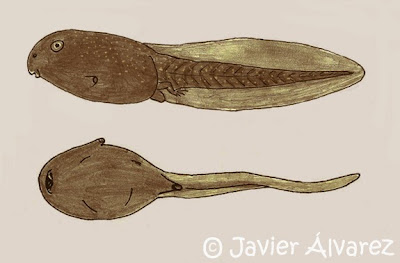 | Si hay un grupo entre los herpetos riojanos que pueda representar un auténtico reto en cuanto a su identificación, este podría estar constituido por los renacuajos. En verdad se asemejan tanto, que tratar de distinguir entre sí las diferentes especies puede sonar a chiste. No obstante y aunque hay especímenes realmente difíciles de identificar, no se trata de una tarea imposible si tenemos en cuenta determinados aspectos de su anatomía. Leer más. |





Philip de Pous, Albert Montori, Fèlix Amat, Delfí Sanuy. Regional Environmental Change. 24 May 2015. The present study indicates that climate change drastically reduces the potential distribution range of C. asper and reveals dispersal possibilities to be minimal under the most realistic dispersal scenarios. Despite the major loss in suitable climate, the models highlight relatively large stable areas throughout the species core distribution area indicating persistence of populations over time. The results, however, show a major loss of genetic diversity and evolutionary history. Leer más.
 | Durante nuestra estancia en Hungría tuvimos la oportunidad de conocer de cerca el programa de recuperación del galápago europeo (Emys orbicularis). Acompañamos al equipo de guardabosques en unas actuaciones para erradicar galápagos de Florida introducidos (Trachemys scripta), y visitamos una zona de cría del galápago donde se protegen sus nidos de los depredadores. Leer más. |
A unique adaptation in the foot of birds is the presence of a thumb-like opposable toe, which allows them to grasp and perch. However, in their dinosaur ancestors, this toe was small and non- opposable, and did not even touch the ground, resembling the dewclaws of dogs and cats. Leer más.






